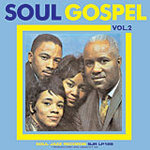|
|
 |
Dusted Reviews
Artist: V/A Album: Soul Gospel 2 Label: Soul Jazz Review date: Jul. 5, 2006 |

|
|
|
 |
African-American music has its roots in spirituals; the synthesis of traditional European religious songs combined with retained African memories and sensibilities. Though post-Emancipation music became increasingly secular as leisure extended beyond church, the forms and practices of the spirituals persisted in black music. It’s a connection that Soul Jazz records has sought to make more explicit in its Soul Gospel series, now in its second volume. Soul Gospel 2 contains musical juxtapositions of religious and secular elements that fall within the gospel genre, though the results often spill out into the popular conception of soul music.
Soul Gospel 2, like its predecessor, focuses on artists that are firmly in the gospel camp, rather than soul singers dabbling in religious material. These gospel singers, however, were in tune with contemporary secular musical happenings, sending out their message in music that was accessible to urban black communities. Loleatta Holloway scorns a wayward playboy over a Motown-lite arrangement on “Casanova,” while Sweet Inspiration delve into a more southern, blue-inflected soul on “Why Am I Treated So Bad.” The artists’ repertoires aren’t limited to the golden era; Stax-inspired horns give way to disco on the Howard Lemon Singers’ “Let Him Come In,” and Marion Gaines Singers look to the psychedelic funk grooves of Sly Stone and Funkadelic on “Do Your Thing.” The points of reference highlight the versatility of the gospel tradition, while making most of the tracks on Soul Gospel 2 virtually indistinguishable – in both quality and style – from their soul contemporaries.
The similarities can be as conspicuous as Pastor T.L. Barrett’s use of a backing choir on “After the Rain,” or as subtle as Della Reese’s manic stream-of-consciousness that’s layered over fuzz guitar on “Who is She.” Lyrically, subtlety wins out, as references to scripture and Christianity are kept to a minimum. However, songs like The Staple Singers’ rendition of Buffalo Springfield’s “For What It’s Worth” show that the real communication of the Gospel is in delivery. The original’s ominous response to the late-’60s Sunset Strip riots is sung to imply a divine response to the sins of America. It hints at the inescapable religious quality of soul music, mandated simply by vocal style and independent of topical considerations.
There’s a definite lack of progression, whether it be musical or historical, between Soul Gospel and Soul Gospel 2. It’s not just in the source material, though gospel mainstays like Marion Williams, The Staple Singers, and Della Reese make repeat appearances. Rather, both compilations seem similarly situated on the spectrum that connects African-American spiritual music and its more commercial counterpart. This belies the series’ point – Soul Gospel 2 doesn’t give a map from one point to another, it’s a collection of tracks that questions the distance in between.
By Bob Hammond
|







